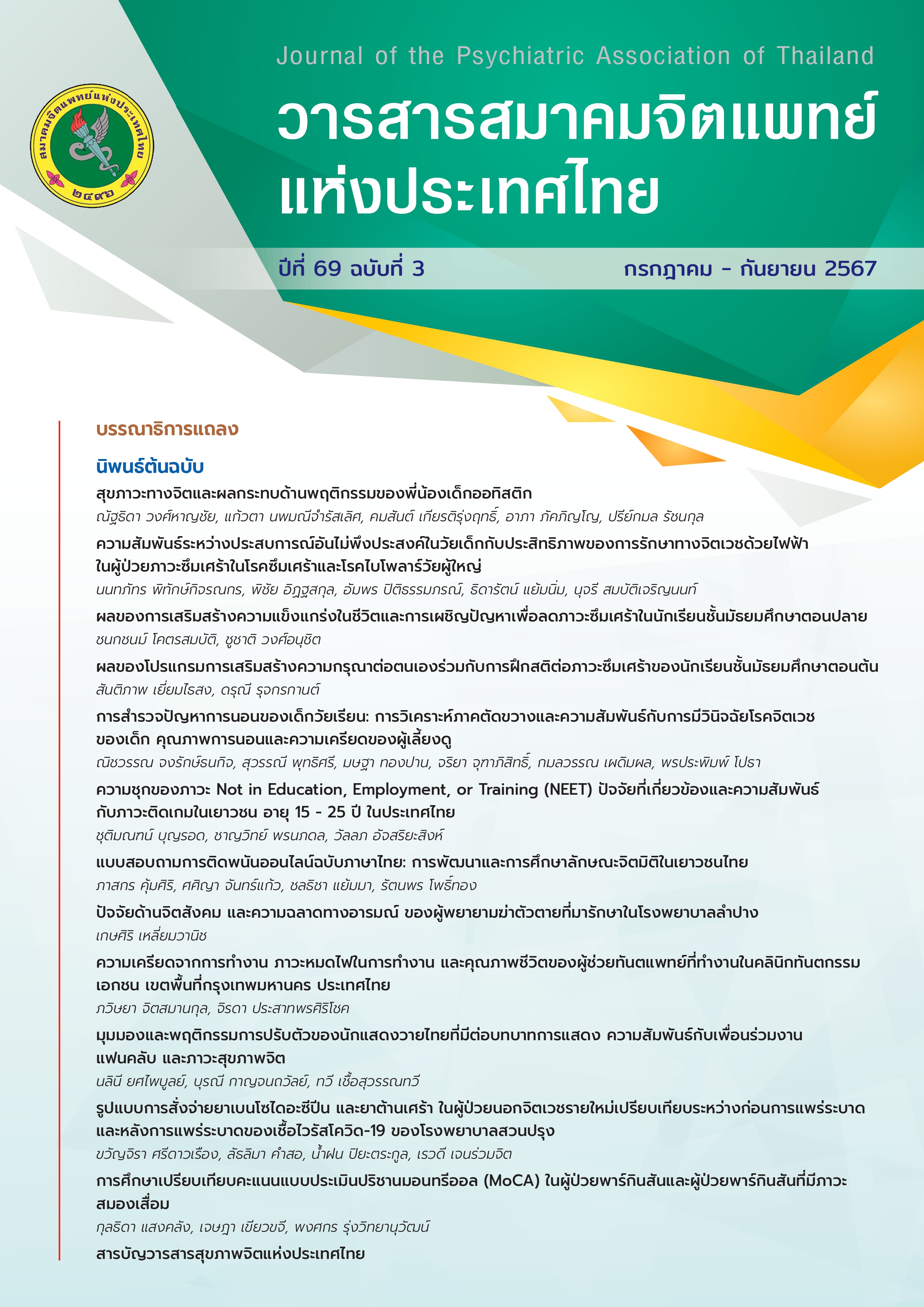Prevalence of Not in Education, Employment, or Training (NEET), Associated Factors, and the Relationship with Game Addiction Among Youth Aged 15 - 25 Years in Thailand
Main Article Content
Abstract
Objectives: This study aimed to investigate the prevalence and associated factors of NEET, examine psychiatric disorders in youth with NEET, and explore the association between NEET and game addiction among youth in Thailand.
Methods: This questionnaire-based cross-sectional study was conducted among youth aged 15 - 25 years from July to November 2023. Participants were recruited from communities across 15 provinces in Thailand using a stratified and multi-stage sampling method. The questionnaire included demographic data, NEET status and related characteristics, gaming behavior, and positive parenting. Furthermore, game addiction was assessed using Gaming Disorder Scale: GAME-S, while other psychiatric disorders were evaluated using the Mini Neuropsychiatric Interview (M.I.N.I.). The data analysis employed descriptive statistics and inferential statistics, including Chi-square, T-test, and Analysis of Variance (ANOVA).
Results: The participants included 668 youths and their parents with equal proportions of males and females, with a mean age of 19.92 years. The prevalence of NEET was 4.5%. Factors associated with NEET were older age and playing video games with strangers or online friends (OR=3.39; 95%CI [1.01, 11.42]), and playing alone (OR=3.30; 95%CI [1.15, 9.46]). In contrast, gender, main caregiver, screen time, game addiction, and positive parenting were not associated with NEET. Additionally, psychiatric diseases found in youth with NEET were alcohol abuse (3.3%) and major depressive disorder (3.3%).
Conclusion: The prevalence of youth with NEET is 4.5%, and comorbid psychiatric diseases of those youth include alcohol abuse and major depressive disorder. The interpretation of the association between studied factors and NEET is limited due to the limited number of youth identified as NEET.
Article Details

This work is licensed under a Creative Commons Attribution-NonCommercial-NoDerivatives 4.0 International License.
Articles submitted for consideration must not have been previously published or accepted for publication in any other journal, and must not be under review by any other journal.
References
Social Exclusion Unit. Bridging the gap: new opportunities for 16-18 year olds not in education, employment or training, presented to Parliament by the Prime Minister. London, UK: Stationery Office; 1999.
Ministry of Health, Labour and Welfare of Japan. Employment measures in Post-Financial Crisis Japan [Internet]. 2009 [cited 2021 Jun 16]. Available from: http://www.mhlw.go.jp/english/policy/affairs/dl/04.pdf.
Tanton C, McDonagh L, Cabecinha M, Clifton S, Geary R, Rait G, et al. How does the sexual, physical and mental health of young adults not in education, employment or training (NEET) compare to workers and students? BMC Public Health 2021;21(1):412.
Yang Y. China’s youth in NEET (Not in Education, Employment, or Training): evidence from a national survey. Annals AAPSS. 2020;688(1):171–89.
Bhulaor R, Saengprajakkul S, Thongwan P. Report of knowledge building and promotion of youth who are not in Employment, Education or Training (NEETs), and youth who are disengaged in human capital accumulation activities for fostering youth potential to enter into the labor market. Bangkok: Thai Health Promotion Foundation; 2020.
Benjet C, Hernández-Montoya D, Borges G, Méndez E, Medina-Mora ME, Aguilar-Gaxiola S. Youth who neither study nor work: mental health, education and employment. Salud Pública Méx. 2012;54(4):410-7.
Gariépy G, Iyer S. The mental health of young Canadians who are not working or in school. Canadian J Psychiatry. 2019;64(5):338-44.
Bania EV, Eckhoff C, Kvernmo S. Not engaged in education, employment or training (NEET) in an Arctic sociocultural context: the NAAHS cohort study. BMJ Open 2019;9(3):e023705.
European Foundation for the Improvement of Living and Working Conditions. NEETs, young people not in employment, education or training: characteristics, costs and policy responses in Europe. [Internet]. LU: Publications Office; 2012 [cited 16 Jun 2021]. Available from: https://data.europa.eu/doi/10.2806/41578.
American Psychiatric Association. Diagnostic and statistical manual of mental disorders (DSM-5). 5th ed. Washington, DC: American Psychiatric Publishing; 2013.
World Health Organization. The ICD-11 classification of mental and behavioral disorders: diagnostic criteria for research. Geneva: World Health Organization; 2018.
HealthyGamer.net. Gaming addiction situation in Thai children: review [Internet]. 2014 [cited 2021 Aug 20]. Available from: https://www.healthygamer.net/manage/uploads/review_of_game_addictions_situation_05-2557.pdf.
Bhatiasvi V, Pholphiru P. Online gaming addiction among in Thai children [Internet]. 2020 [cited 2021 Aug 20]. Available from: https://www.posttoday.com/columnist/640863.
Gentile DA, Bailey K, Bavelier D, Brockmyer JF, Cash H, Coyne SM, et al. Internet gaming disorder in children and adolescents. Pediatrics 2017;140(Suppl 2):S81-5.
Paulus FW, Ohmann S, von Gontard A, Popow C. Internet gaming disorder in children and adolescents: a systematic review. Develop Med Child Neuro 2018;60(7):645–59.
VAN Rooij AJ, Kuss DJ, Griffiths MD, Shorter GW, Schoenmakers MT, VAN DE Mheen D. The (co-)occurrence of problematic video gaming, substance use, and psychosocial problems in adolescents. J Behav Addict. 2014;3(3):157-65.
Pontes HM, Griffiths MD. Measuring DSM-5 Internet Gaming Disorder: development and validation of a short psychometric scale. Comput Human Behav 2015;45:137-43.
Sangkhaphan T, Pornnoppadol C, Hataiyusuk S. The Development of Gaming Disorder Scale (GAME-S). J Psychiatr Assoc Thailand [Internet]. 2023 Mar. 29 [cited 2021 Jun 16];68(1). Available from: https://he01.tci-thaijo.org/index.php/JPAT/article/view/258969.
Kittirattanapaiboon P, Khamwongpin M. The validity of the Mini International Neuropsychiatric Interview (M.I.N.I)-Thai version. J Ment Health Thai. 2005;13(3):125-35.
Pornnoppadol C. Report of Effectiveness of an Internet-Based Parent Management Training Program (Net PAMA). Bangkok:Thai Health Promotion Foundation; 2022.
Tullett-Prado D, Stavropoulos V, Mueller K, Sharples J, Footitt TA. Internet Gaming Disorder profiles and their associations with social engagement behaviours. J Psychiatr Res 2021;138:393-403.
Pilz M, Schmidt-Altmann K, Eswein M. Problematic transitions from school to employment: freeters and NEETs in Japan and Germany. Compare 2015;45(1):70-93.
Kato TA, Shinfuku N, Tateno M. Internet society, internet addiction, and pathological social withdrawal: the chicken and egg dilemma for internet addiction and hikikomori. Curr Opin Psychiatry 2020;33(3):26470.
Schuckit MA, Tipp JE, Bergman M, Reich W, Hesselbrock VM, Smith TL. Comparison of induced and independent major depressive disorders in 2,945 alcoholics. Am J Psychiatry 1997;154(7):948-57.
Grazioli VS, Bagge CL, Studer J, Bertholet N, Rougemont-Bücking A, Mohler-Kuo M, et al. Depressive symptoms, alcohol use and coping drinking motives: Examining various pathways to suicide attempts among young men. J Affect Disord 2018;232:243-51.


